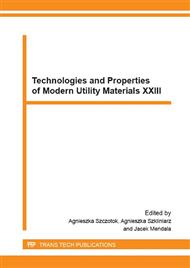p.207
p.213
p.217
p.221
p.225
p.231
p.235
p.240
p.244
The Influence of the Components of the Bimetallic Tubes for the Way of Deforming in the Hollow Drawing Process
Abstract:
Processes for producing bimetallic tubes can be divided for: producing the bimetallic tubes in the cold process, with preheating or with the heat treatment after each pull. First method relates to the metal with high ductility (copper, copper alloys, aluminum, aluminum alloys, zinc, etc.), second to the metals or bi-metal components, in one of which has significantly different plastic properties from the second for example: low-carbon steel, high alloy steel, etc. One of the methods for the production of bimetallic tubes is hollow cold drawing process. In this process the wall thickness is changed, which means the wall becomes thicker, the wall becomes thinner or remains unchanged. The aim of the research was to determine the effect of the influence of the share of components of bimetallic cooper tube species M1E, and the copper tube - species M63 in the arrangement M1E - M63 and M63 - M1E in the tubes hollow drawing process for the distribution and size of deformation of the individual layers. The research program included:- production of the bimetallic tubes by hollow drawing with a different percentage of the cross-section components and with a variable arrangement of layers,- determination of the size and distribution of true strain of the individual layers on the cross-section of bimetallic tube,- determination of replacement/equivalent strain for the deformable wall of the bimetallic tube,- evaluation of the usability of the graph of changes in thickness of the tube wall in the hollow drawing process for the drawing process of the bimetallic tubes.
Info:
Periodical:
Pages:
225-230
Citation:
Online since:
February 2016
Authors:
Price:
Сopyright:
© 2016 Trans Tech Publications Ltd. All Rights Reserved
Share:
Citation:


